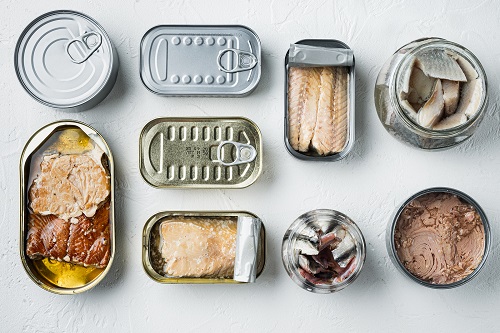Fats have a bad reputation, but there are many types of fat that are good for our health. In fact, healthy fats contain nutrients and protect our organs. They also support a healthy heart and help our bodies absorb other nutrients.
Each month this year, we are featuring a different food group or sub-group as part of our Food Talk Features… Series. Last month, we oohed and ahhed over the other vegetables sub-group. Other vegetables contain lots of different nutrients, and that means lots of delicious flavors! Other vegetables are also great sources of fiber and water. Check out our Other Vegetables blog to learn more!
This month, we’re focused on fat. Not just any fat—oils and other sources of unsaturated fat! While saturated fats are not health-promoting (we’ll talk about why!), there are still many sources of fats that we consider “heart healthy.”

What are unsaturated fats and their benefits?
According to the Dietary Guidelines for Americans, oils and unsaturated fats are not their own food group. However, they are still important in a healthy diet. We should limit saturated fat from foods like meat and any fats that are solid at room temperature. These fats include:
- Butter
- Coconut oil
- Lard
- Shortening
- Palm oil [1]
Saturated fats are not good for our heart health. This is because these fats have a shape that makes them harder to flow through the body. As a result, the fat builds up in our blood vessels. Eating too much saturated fat over a long period of time can result in high cholesterol. High cholesterol can lead to heart disease or heart attacks. [2] [3]
But there is good news! We can protect our heart health through the food choices we make over our lifetime. Instead, we should focus on unsaturated fats! Replacing some of our saturated fat foods with foods that contain unsaturated fat is a good start. [4] We talk more about the importance of a heart healthy diet in our Healthy Aging for the Heart blog here.
Unsaturated fats are liquid at room temperature, and they are more healthful than saturated fats. Like the name says, they are “un” (not) “saturated” (filled). This is just a way of saying that shape of the fat is less full. The shape makes these fats easier to flow through the body. In fact, while they flow through the body, they pick up unwelcome substances to help lower blood cholesterol. Unsaturated fats help to protect the heart from any blockages! [3] That’s why we often call unsaturated fat the “healthy” fat!
Unsaturated fats like oils are also important for keeping the body healthy overall:
- Fats are needed to protect organs as we move or in case we get injured.
- Some vitamins are best absorbed when fat is eaten with them. These are vitamins A, D, E, and K.
- Fat is also needed to keep our body temperature normal when temperatures change outside.
- Unsaturated fats like oils contain vitamin E—an antioxidant that protects our cells from damage. Most Americans don’t get enough vitamin E! [1] [5]

You may recognize some sources of unsaturated fat in other food groups. Many foods in the food groups contain healthy fats. There are some fats we get while we prepare our meals. Sources of healthy fats include:
- Cooking oils like canola, olive, and peanut oil (and other plant-based oils—except for coconut and palm oil)
- Nuts and seeds like flaxseed, chia seeds, and walnuts
- Fish like salmon, tuna, herring, trout, and mackerel
- Veggies like avocados, soybeans, and olives
- Spreads like peanut butter, hummus, and guacamole
- Condiments like mayonnaise made with olive oil and oil-based salad dressings

How much do I need?
There is no set amount of fat and oils we need each day. The American Heart Association recommends about 3 tablespoons of healthy fats each day, but this is an estimate! [6] For example, using 1 tablespoon of vegetable oil to cook up eggs or veggies goes towards our daily intake.
It’s not easy to tell what 1 tablespoon of unsaturated fat looks like in our foods. Instead, focus on eating a variety of foods that contain unsaturated fats!
Some nutrition facts labels will show you the kinds of fat in that product. Limit your intake of saturated fat to less than 5 grams per serving (about 20 grams per day). Don’t worry if most of the total fat on the label is coming from unsaturated fats. Check out our Food Label Facts blog for more on how fats are written on nutrition labels. Fats may also appear on a nutrition facts label with different names. You can learn more about what fats are listed as, and why, in this All About Fats blog.

Unsure how to get enough unsaturated fats and oils? Try these recipes!
Adding healthy fats to meals will help you get enough of them without the stress of counting out sources each day. Consider eating one of the fish options listed above once or twice a week. And don’t forget—canned, frozen, and shelf-stable versions of these foods are still just as nutritious! Be mindful of sodium content, but you can buy the options that work best for your family.
Think about making most of your meals “heart healthy.” A heart healthy diet limits sodium and saturated fat to support blood flow. It also focuses on plenty of fruits and veggies—count us in! Check out our blog on creating heart healthy meals by clicking here.
For ideas on how to incorporate healthy fats into your recipes, we’ve got you covered! Get mealtime inspiration with Food Talk recipes that contain oils and unsaturated fat:
- Make your own oil-and-vinegar salad dressing. Read through our Harvest Kale Salad and Kale and Orange Salad for inspiration. Use a bit of oil-based mayo to make a creamy dressing like our Spinach & Romaine Salad with Strawberries and Poppyseed Dressing!
- Create a heart-healthy salad using nuts and seeds. Pecans, walnuts, and seeds like pumpkin seeds are delicious, crunchy additions! Try Spinach and Pecan Salad with Lemon Vinaigrette or Crunchy Apple Salad for pecans that pack a punch of nutrition!
- For more heart healthy fats, whip up Southern Bread Salad with Olives and Pecans or a fish-filled Festive Tuna Salad. Canned fish is also delicious in sandwiches, on crackers, or as part of a salad!
- Add a boost of healthy fat with ground flaxseed or chia seeds in your breakfast. We love this Banana Pudding Overnight Oats recipe that includes chia seeds.
- Anytime you cook with oil, you’ll eat some with the cooked dish, too. Give our West African Peanut Stew a try for two sources of healthy fats from the cooking oil and peanut butter!
- Add spreads like hummus or guacamole to sandwiches and wraps. Try using them as dips for veggies and pita bread! We have a delicious Greens and Beans Dip with heart healthy avocado.
If you’ve feared fat in the past, take the facts shared here as your sign to find ways to enjoy oils and unsaturated fats in your diet! This concludes the last topic in our Food Talk Features… Series. Tune in next month for a final wrap-up blog where we’ll review what we’ve learned about the food groups.
Written by Melanie Ng, Ph.D. Candidate | Edited by Leslie Davis, MS, RD, LD, CDCES and the Nutrition Education Team
Published: November 8, 2021
[1] MyPlate—More Key Topics (Oils)
[2] American Heart Association—Saturated Fats
[3] American Heart Association—Unsaturated Fats
[4] FDA—Interactive Nutrition Facts Label (Fats)
[5] American Heart Association—Dietary Fats
[6] American Heart Association—Food Group Serving Sizes

